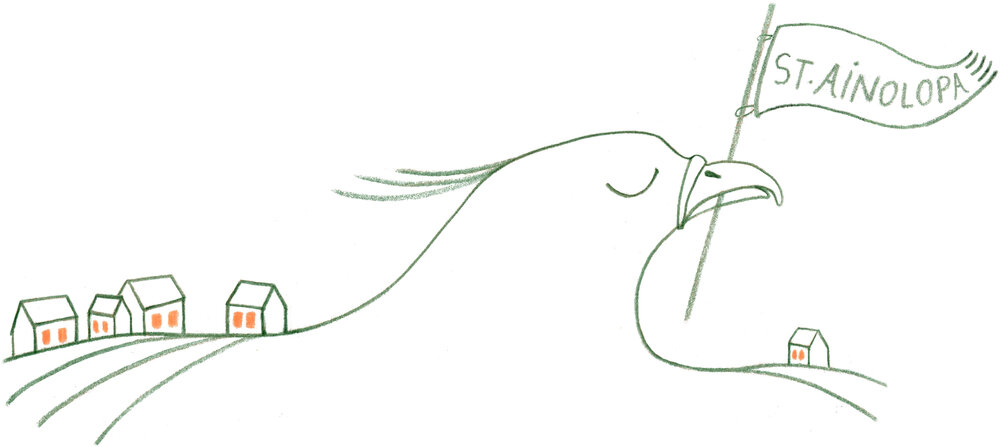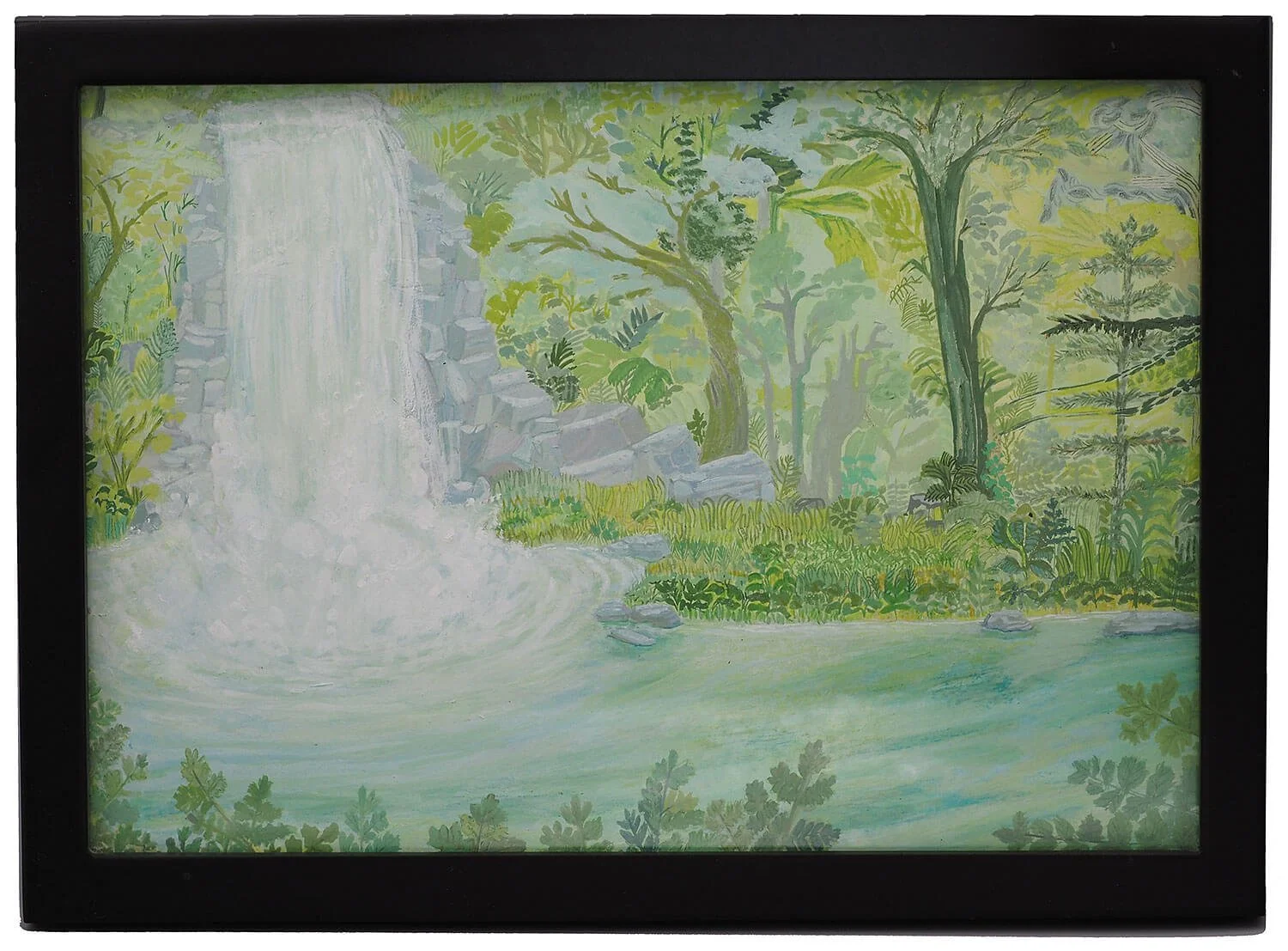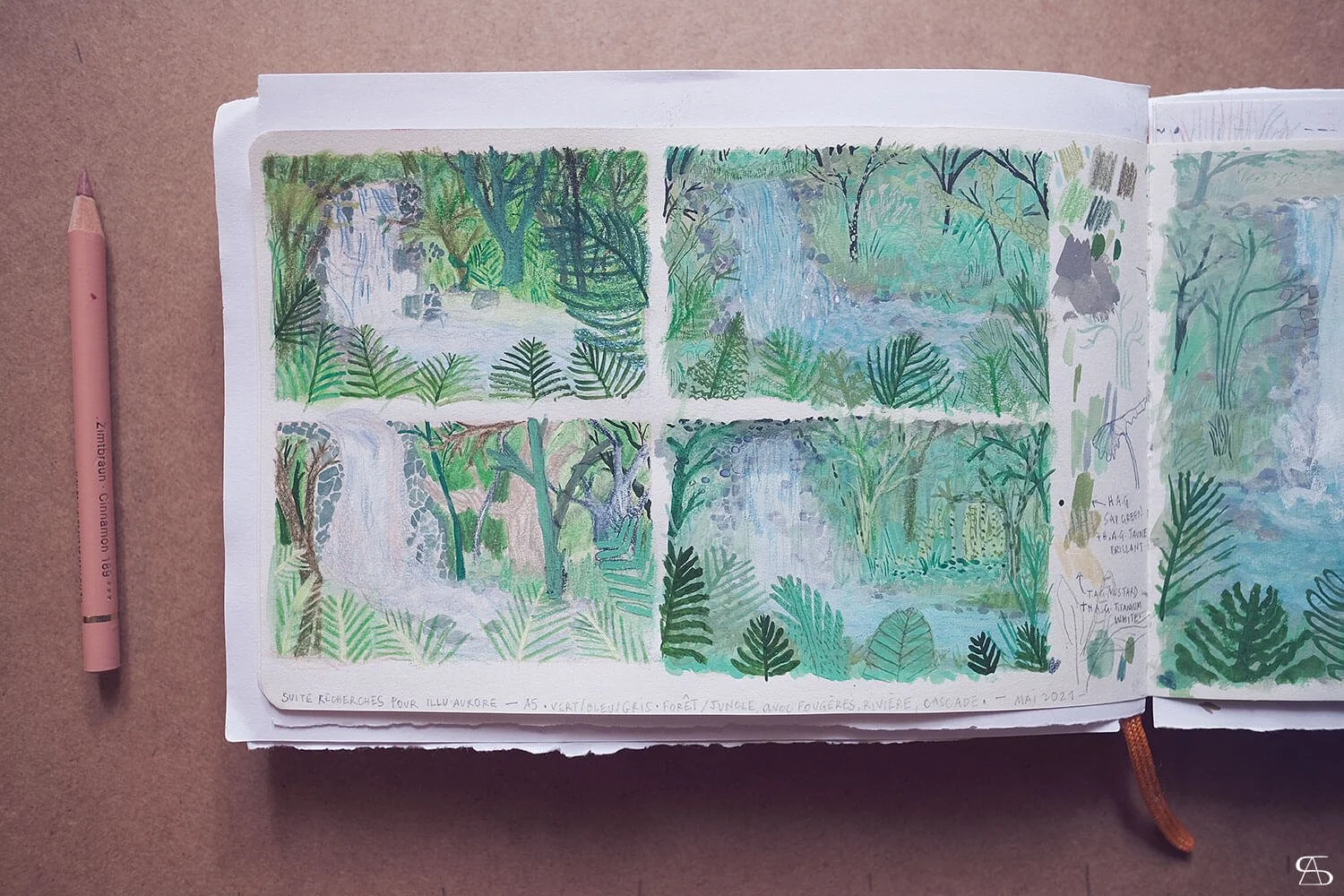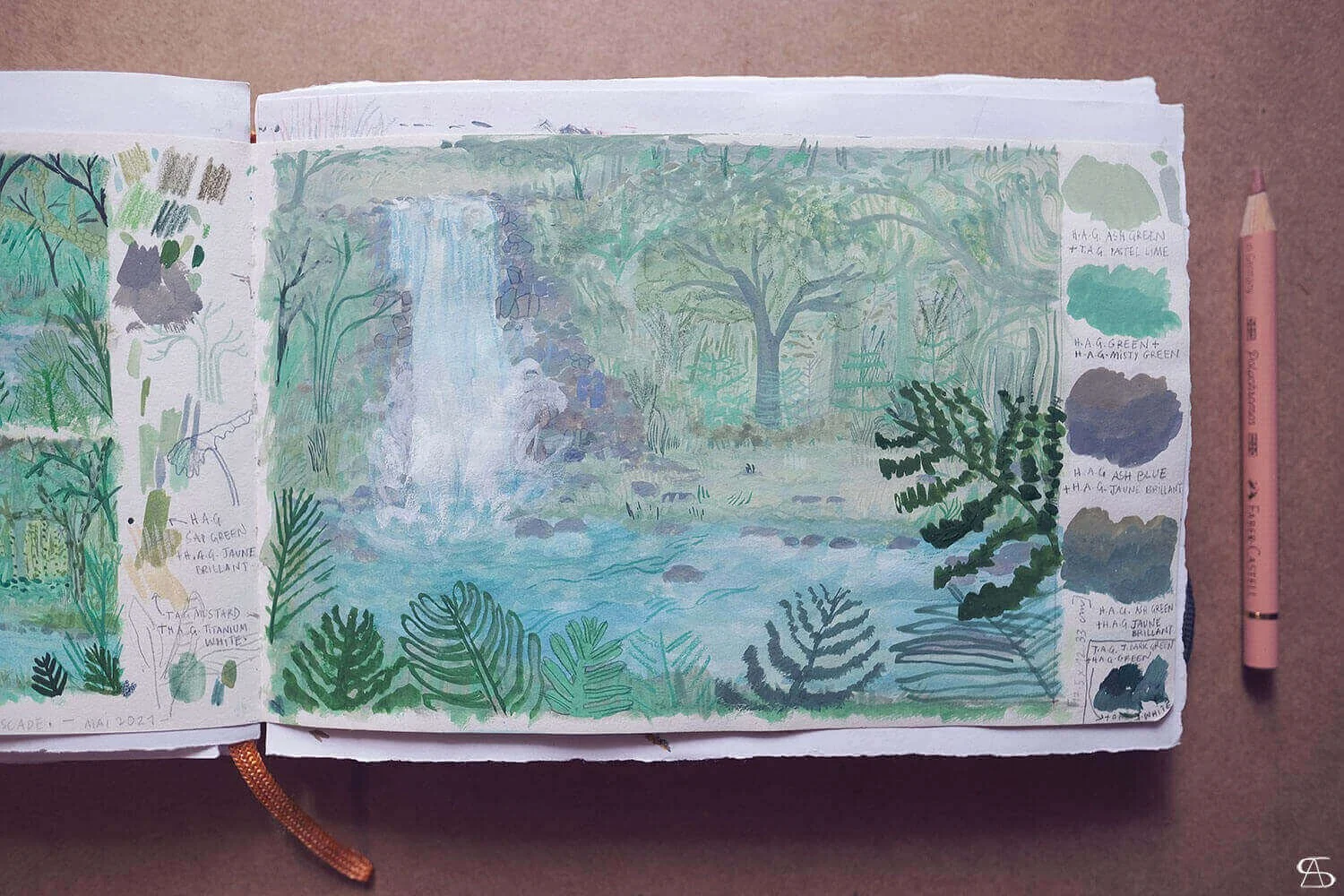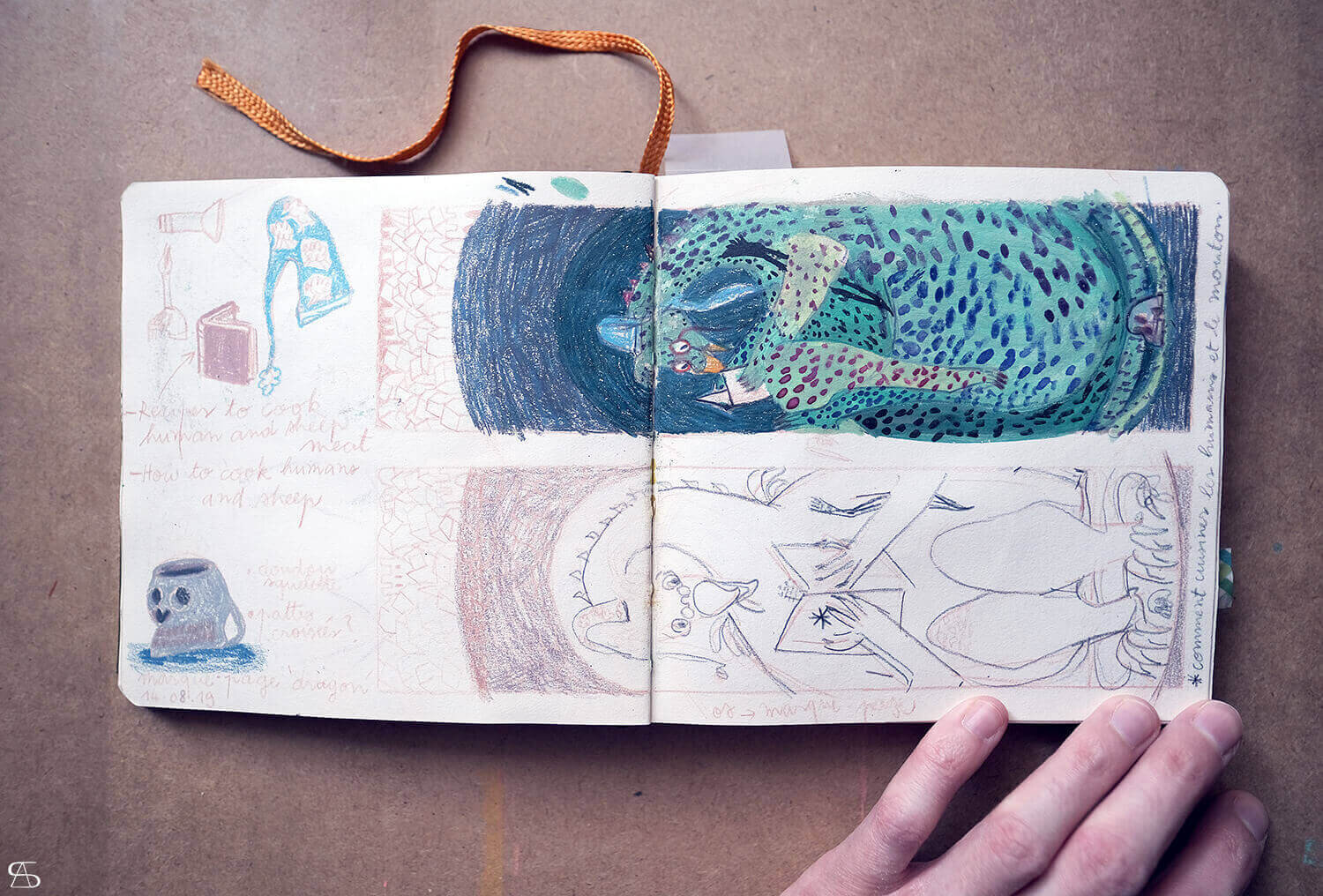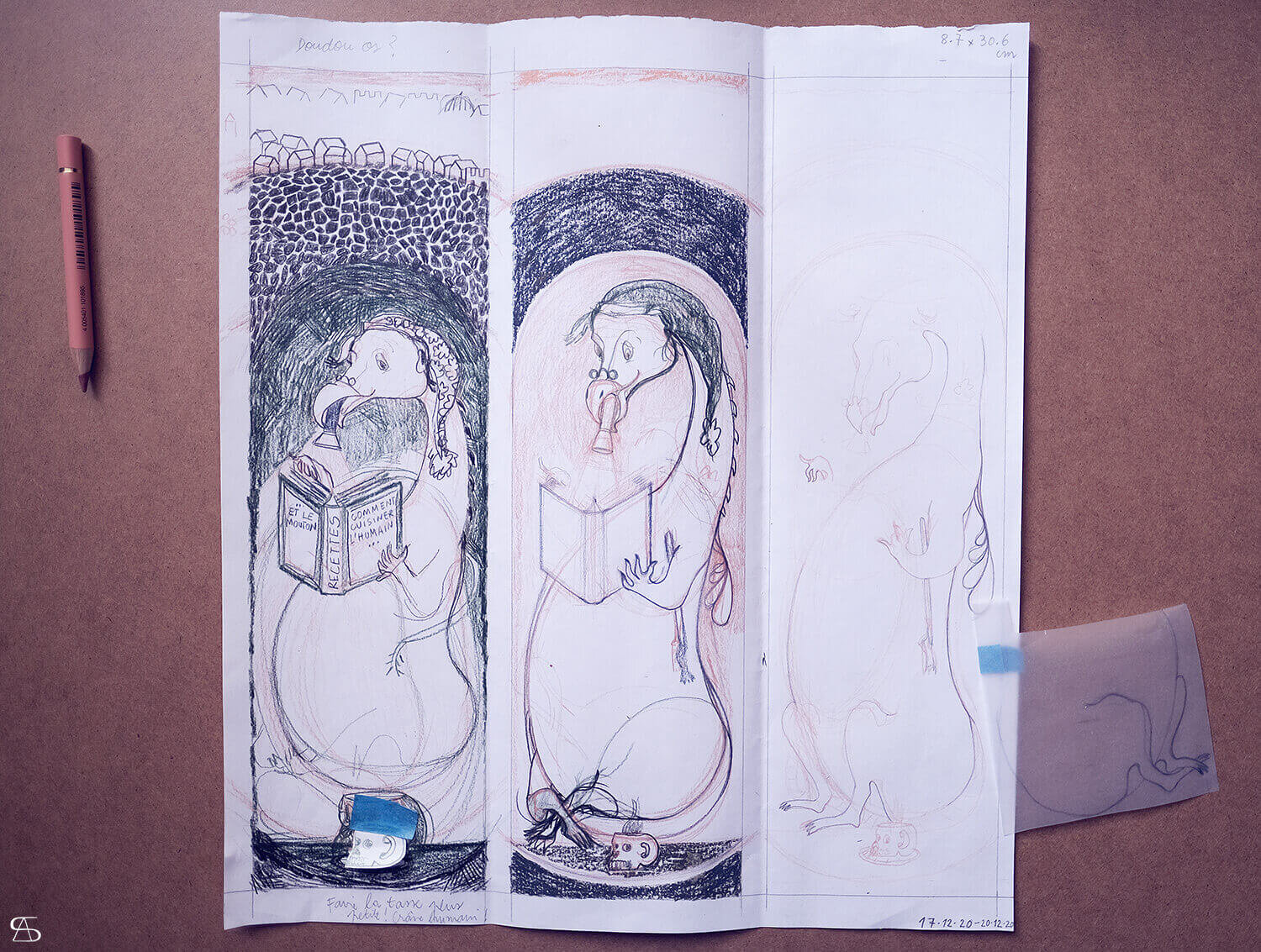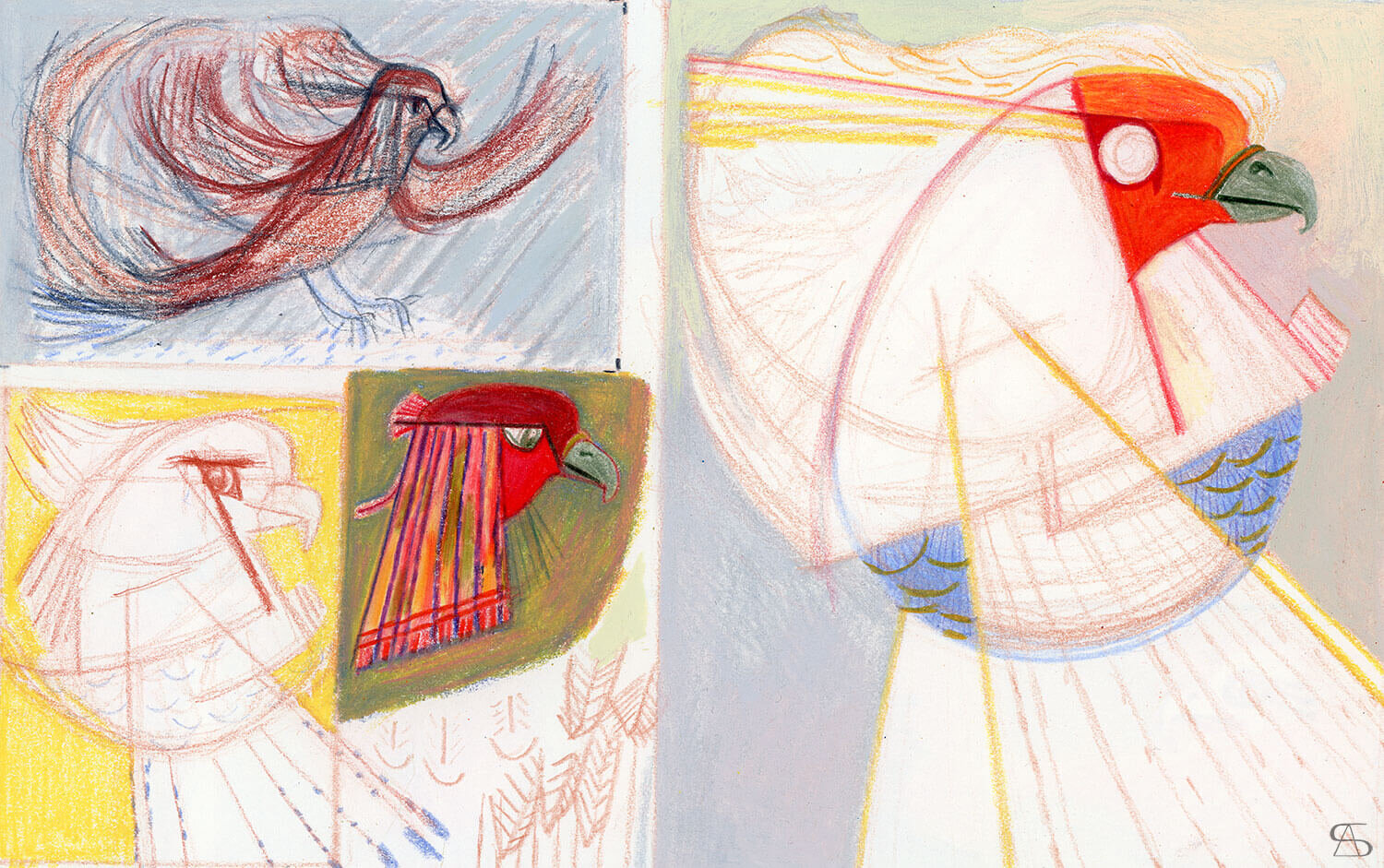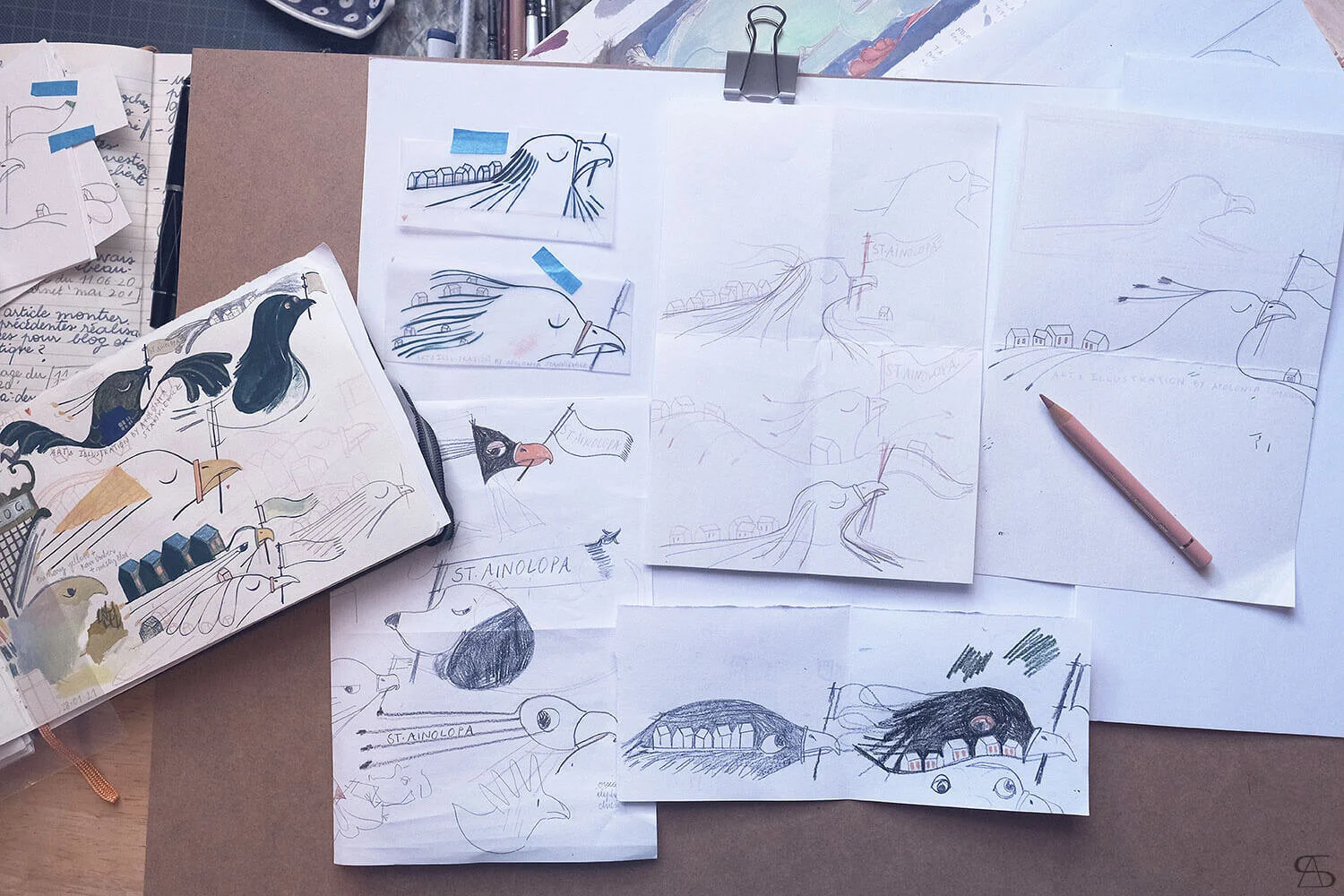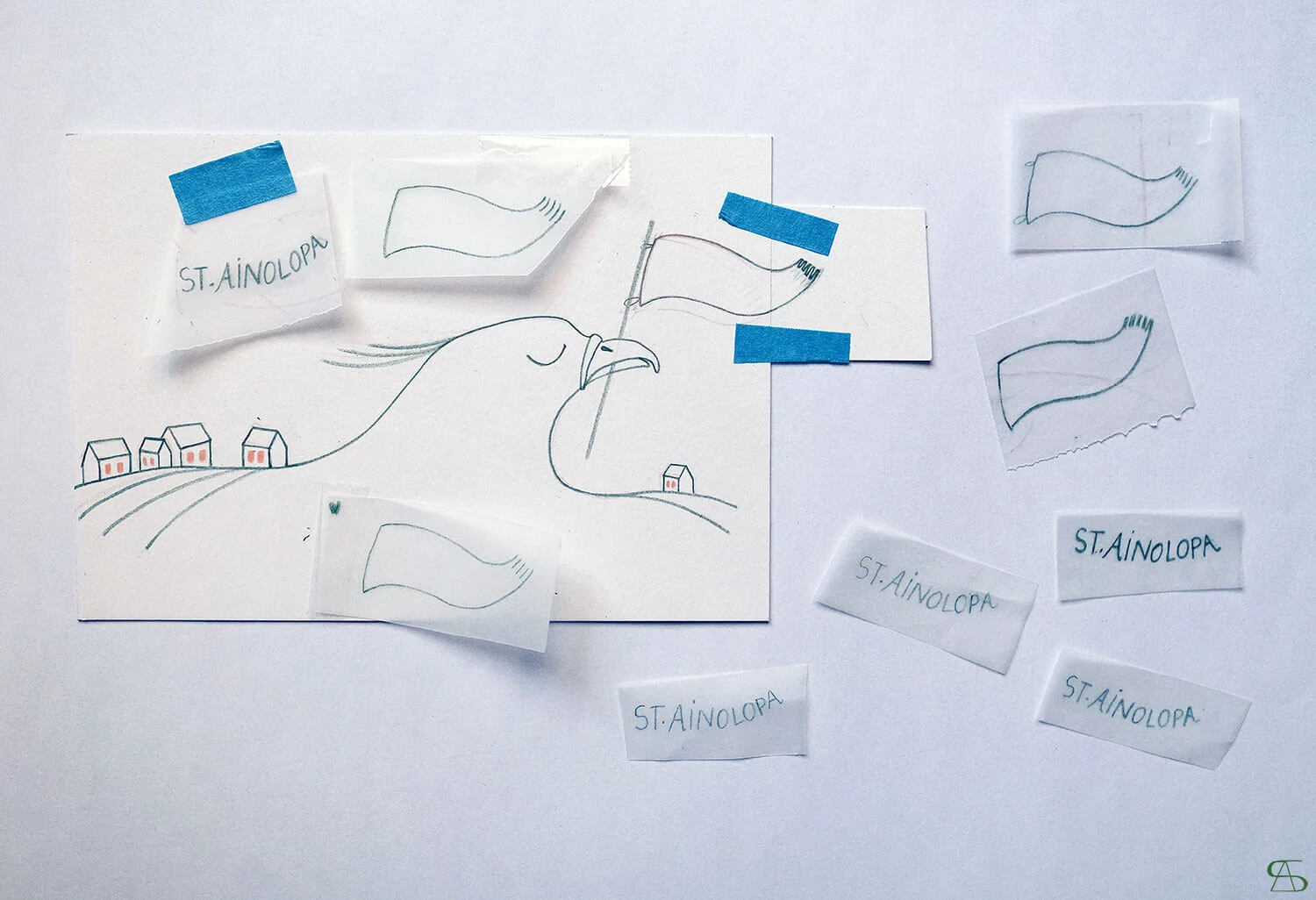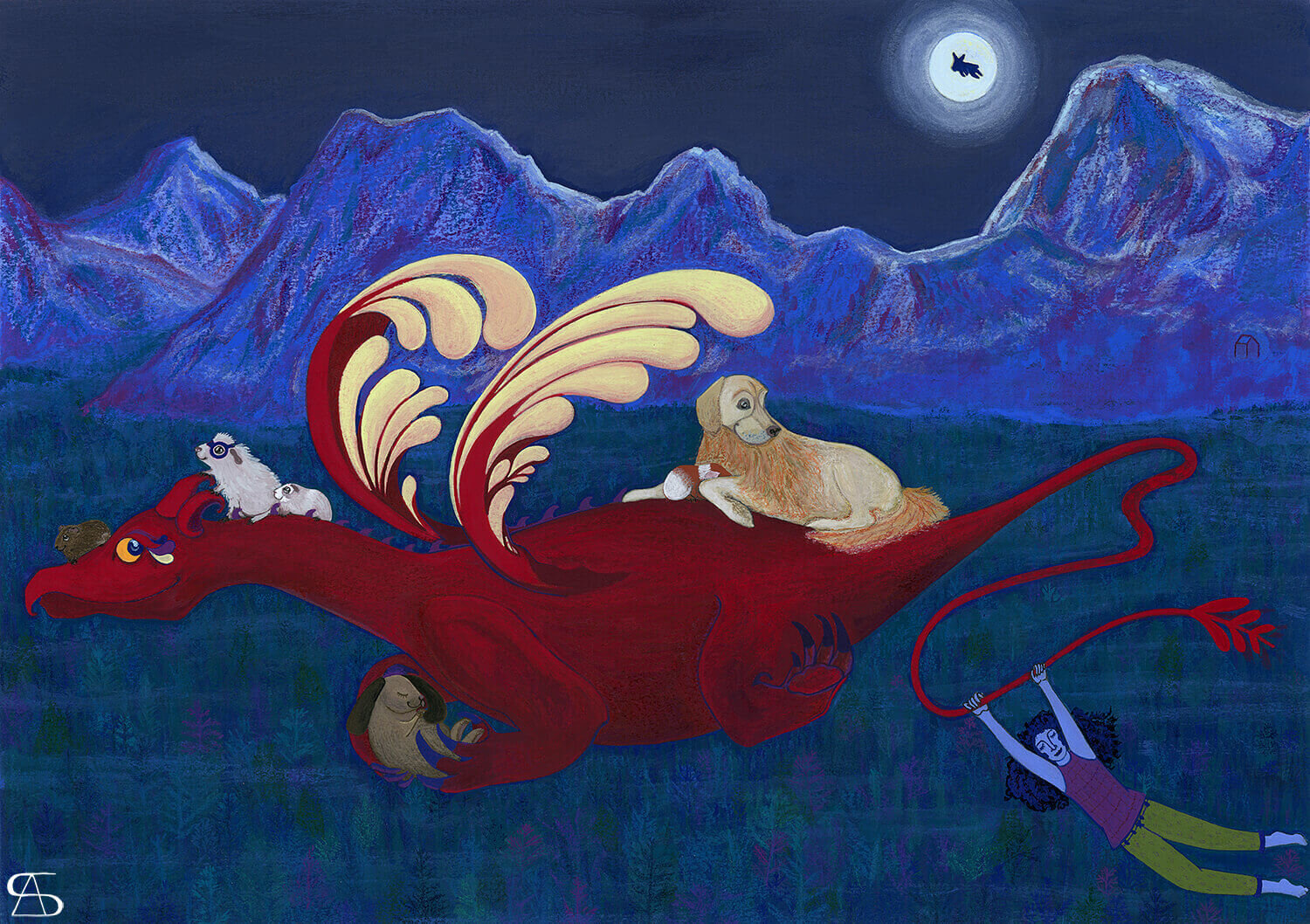Hello dear reader!
Thank you for taking the time to peruse this post in particular, I am afraid it has turned out to be quite long :)
Today on the blog, I would like to delve into the making of Beyond the ferns, an illustration I finished in June 2021 for a private client (see photo below).
That project was a tough one, in that I was forced to face a hindering flaw of mine which keeps on emerging whenever I set to work. But this time, there was absolutely no way around it! I had to shake it off somehow, so I could complete the illustration and finally deliver it to the client. Oh my, what a journey…
See above a part of the research I did for the final illustration Beyond the ferns (2021).
A little close-up of the research for Beyond the ferns (2021).
For this commission, the client had a very clear idea of the picture she wanted me to make. She delineated the assignment carefully, and guided me through all of my sketches so my creative instinct did not run wild.
Some of you may think it is a bad thing to ‘harness’ somebody’s creativity, give the latter specific boundaries, and I am in most cases of the same opinion when it comes to making Art — with a capital ‘A’. How can I express myself as an individual, be sincere and honest, and make original artwork if I am hampered by guidelines? How to get inspired and bring out new ideas then?
On the other hand, I am dealing here with a commission, period. This is not about my artistic aspirations, but mostly about the client who likes my style and whom I am selling a service to. I am crafting a picture on order for someone, not myself.
And, what’s more, I have come to like that kind of exercise. I have realized that through boundaries and some assignments, new ideas and new skills do blossom — always in an unexpected way, you never know when. They actually help me evolving in my personal work. Who would have guessed?
I must admit that sometimes commissions also make me feel safe in that I do not overthink things. I do not get precious and self-conscious while exploring and experimenting. I do not get lost in research and personal thoughts for an indefinite period of time — having self-doubts, not knowing if I will ever be able to finish my illustration one day. I ‘just’ make a picture, and deliver it to a client who has what they want.
But I digress. Let’s go back to topic, shall we?
I was asked to create a cross between a forest and a jungle in A5 format (that is 148 x 210 mm, roughly 6 x 8 in). It got decided after a few sketches that a landscape format was better than a portrait format as I had to fit several elements the client wanted to see in the illustration. Those elements are as follows: a cascade, a river, rocks here and there, and most important ferns as part of the vegetation. In terms of colour palette I was asked to use greens, blues, and greys. Nothing more. There goes the beloved automnal shades :D
The main difficulty I had to deal with — encompassing a myriad of other ones later on — was to achieve balance in depicting the greenery. How do I paint foliage in such a way it is not overloaded and unreadable? How do I avoid making a mess here? Where do I begin? What will happen when I make a mistake? Why is the piece of paper in front of me perfectly white and immaculate? Why did I accept the commission? That is when the trouble began for me — from the outset —, and the reason for my writing this very post today.
An exploration into the dread of the final version while creating a picture.
Odes should be written about sketchbooks. I love my sketchbooks. They are comforting, I feel like in a cocoon when I doodle there. I feel safe and free to indulge in drawing whatever comes to my mind, in lots of different ways, out of sight.
No pressure. No worries.
Then comes the final version. The point is reached when I am done with research and drafts — there is nothing more to do, hurry up, the clock is ticking! —, and I am to set about making the actual illustration to be delivered to the client. I am T-E-R-R-I-F-I-E-D.
How did I get into that predicament? Why do I dread the final version of each illustration I make so very much? A time-consuming introspection was needed here…
School is where it all begins. Of course… What a predictable thing to say, right? How boring one might even add. Please bear with me a little longer. I am not going to list here school traumas that might have happened when I was a child, and complain about them, I promise. This has to do with some of the methods used in the education system when I was taught how to write. I do not know how it is nowadays in France, but in the nineties I used to have a cahier de brouillon or cahier d’essai at school — I have trouble finding the right word in English, is it an exercise book? Everytime I was given a writing task, I would have first to train myself and make a few drafts in the cahier de brouillon, before I actually complete the task on a sheet of paper (or a rather fancy notebook) to be handed in to the teacher. When there was an upcoming mother’s/father’s day, the teacher would ask the pupils to make a nice greeting card or write a nice letter; the message would have to be previously drafted again and again in the cahier de brouillon, before being written down on the card/writing paper — at long last! On top of that, when one did not write straight, or made a mistake, or crossed out words, or left ink stains, they would have to start over as many times as the teacher saw it fit — I was exceptionally gifted when it came to crossing out words and whole sentences :D Through the years in primary school, that method got settled in the pupils’s way of doing work, and subsequently took on other forms in high school and university, to finally become an inherent behaviour in everyday life during adulthood.
My sketchbook is a kind of sandbox located in a dark corner of my brain, an isolated place where I can allow myself anything. I am free from any constraint and can simply let go without worrying about how good what I make is. It has never been meant to be seen by anybody except myself; it is a private space that allows searching, trying and experimenting.
In other words, I have come to operate within a frame which is broken down and acknowledges two separate steps; where a clear distinction is made between the draft version and the final version. That method is maybe a good way to go about writing, but it cannot be translated into the field of picture making, in my opinion. Creating a picture is an ongoing process to be seen as a whole, where one has to work differently. What is made on that perfectly white and immaculate piece of paper should be treated in the same way as what is made inside the comforting sketchbook.
Now, that being said, the theme of vegetation portrayal — this untamed wilderness — is so vast! How do I proceed?
When I look at vegetation, or think about it, I unfortunately see myself approaching it with the same mindset as when I look at a piece of white paper in front of me. I see everything and nothing both at the same time. Infinite emptiness and perfect completeness. Both share the uncanny similarity of being a perfect whole, but also still open to change. They trigger a myriad of ideas, propositions, and ways of doing; there are so many possibilities, so many decisions to be made, and so many risks to be taken! Such freedom can be quite scary! I try to tell myself that because of all those possibilities, there are no bad decisions; one simply selects ideas and then creates the picture freely. However, this is not entirely true. The dreaded challenge lies in the fact that the multiplicity of possibilities implies making arbitrary decisions, narrowing them down to a finite picture that may end up imperfect, if not a failure. The immaculate piece of paper before me is perfection stretching out of sight. Like a beautiful yet eerily enigmatic siren, it mesmerizes me and draws me into the abyss of creation. It is an odyssey where the explorer, also known as the picture maker, confronts absolute emptiness, freedom, and almost infinite possibilities when descending into that abyss.
When I begin to work on a picture, I am at first dazed with exhilaration, eagerness, and a tinge of apprehension – I feel like my dog when it is running in the fields without its leash. I make one decision, like choosing a color for an element on the paper. Then another decision, perhaps a brushstroke here, and another, a line there, and so on. Soon, I realize I've accumulated a plethora of decisions, and I've spent a significant amount of time on my artwork. I’m not immortal you know; time is precious. Doubt begins to creep in, and I become overly cautious, slowing down to contemplate each move. The more decisions I make, the more pressure mounts on my shoulders. I set off a domino effect without knowing its consequences. One wrong decision, and the entire picture crumbles like a house of cards. Every combination of decisions creates a unique image, varying from one series to another. What if I make a mistake? I’m terrified of ruining that sacred and expensive piece of paper, which never demanded anything from anyone. I start feeling inadequate and fear having to start over. To make matters worse, I worry that my next attempt won't be as good as the previous one. At this point, I begin to think the previous version wasn't that bad, after all…
All right, take a break.
For many years, I have been following artists I admire and love. I have attended exhibitions, been entranced by art catalogues and monographs, as well as picture books. I have also read essays on art and personal writings by numerous artists. Over time, I have discovered that almost everyone has a specific topic, color, or medium that intimidates them, and that they tend to avoid. This avoidance may stem from an inherent difficulty, a lack of interest, or a sense of aversion among other factors. If I had to identify one subject that scares me the most or is the most problematic for me, it would be vegetation. I don't mean painting a single tree in isolation, or an individual flower, or a specific plant. Instead, I refer to the cluttered mass of all the trees, plants, and flowers assembled into one comprehensive yet intricate whole, both legible and indecipherable.
Ask me to depict a single tree, and I'm up for the challenge. One flower? Sure, why not. But present me with painting a whole forest, a jungle, a garden, an orchard, and FEAR creeps in right away. Where do I even begin? This leads to my hand seizing up, and suddenly, I'm in a mad dash to escape. I seek refuge in a dark, remote corner, curled up in the fetal position. The inevitable follows – a period of procrastination, complete avoidance, and a considerable social distance from my desk. Suddenly, doing laundry and tackling taxes don't seem as dreadful as this artistic endeavour. Yes, I dared to say it. I start reading new books and working on completely unrelated projects.
So, what's the solution?
Going beyond that dread: a few notes on a process.
For starters, step away from the desk for a moment and go for a walk. Seek inspiration everywhere. Immerse yourself in the artworks of others to rekindle your creative drive. Allow yourself to become intoxicated with their work, igniting your enthusiasm for your own creations. When you're genuinely excited about the work of others and your mind is brimming with a mosaic of visuals, the daunting blank piece of paper no longer blinds you. This state of mind provides a reassuring safety net and empowers your creative journey.
I, for my part, can think of four books that helped me tremendously while working on the making of Beyond the ferns, which are:
Color and Light: A Guide for the Realist Painter by James Gurney;
Arbres - Carnet de dessin by Michel Racine;
Le Douanier Rousseau : Jungles à Paris by Catherine Guillot.
And two movies :
The Lost City of Z (2016) by James Gray;
The Jungle Book (1967) by Wolfgang Reitherman.
Then, take a mental eraser and remove 'The' and 'final' before the word 'version' in 'The final version' of any artwork. Here lies the answer. In fact, creating a picture should be seen as an ongoing journey through time. It begins with an idea, develops, and evolves. It is a seamless process, continually in progress until a decision is made to pause it. This pause can be temporary or permanent, or the picture can be integrated into another project where it will undergo further transformation. The finished product at the end is an extension of everything that has come before; it is part of the entire collection of images that have been created thus far. One simply chooses two moments along the continuous line of drawings and paintings to mark a beginning and an end, extracting a fragment of that line to create a single picture among other possible alternatives.
It can be a bit of a trap for someone to consider that they will find confidence in making loads of drafts and while doing so wait until they are ready to get to the final, because they will never know for sure whether they are ready or not. One needs to do-make without wondering if they are ready, and if they have everything it takes to execute what is asked. Picture making should not be viewed in those terms.
One needs to accept that they will never be perfectly ready. While making drafts and conducting countless trials is comforting, in the end, it boils down to 'simply' creating without pondering whether one is prepared or possesses all the necessary qualities to meet the demands. The exercise here is to conduct several trials without passing judgment during the process. The sketchbook and the beautiful piece of paper should be treated in the same manner. Drafts and final versions blend together, becoming indistinguishable from one another. Each picture is a final version in itself; one produces numerous versions, and later, assesses them to determine which one best fits at Time T when the decision is made.
Then one moves forward. On to another exciting and challenging project.
